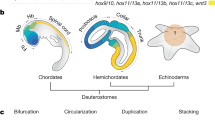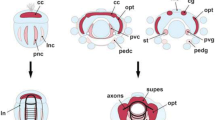Abstract
We documented expression of the pan-metazoan neurogenic gene engrailed in larval and juvenile Patiriella sea stars to determine if this gene patterns bilateral and radial echinoderm nervous systems. Engrailed homologues, containing conserved En protein domains, were cloned from the radial nerve cord. During development, engrailed was expressed in ectodermal (nervous system) and mesodermal (coeloms) derivatives. In larvae, engrailed was expressed in cells lining the larval and future adult coeloms. Engrailed was not expressed in the larval nervous system. As adult-specific developmental programs were switched on during metamorphosis, engrailed was expressed in the central nervous system and peripheral nervous system (PNS), paralleling the pattern of neuropeptide immunolocalisation. Engrailed was first seen in the developing nerve ring and appeared to be up-regulated as the nervous system developed. Expression of engrailed in the nerve plexus of the tube feet, the lobes of the hydrocoel along the adult arm axis, is similar to the reiterated pattern of expression seen in other animals. Engrailed expression in developing nervous tissue reflects its conserved role in neurogenesis, but its broad expression in the adult nervous system of Patiriella differs from the localised expression seen in other bilaterians. The role of engrailed in patterning repeated PNS structures indicates that it may be important in patterning the fivefold organisation of the ambulacrae, a defining feature of the Echinodermata.





Similar content being viewed by others
References
Abzhanov A, Kaufman TC (2000) Evolution of distinct expression patterns for engrailed paralogues in higher crustaceans (Malacostraca). Dev Genes Evol 210:493–506
Adoutte A, Balavoine G, Lartillot N, Lespinet O, Prud'homme B, de Rosa R (2000) The new animal phylogeny: reliability and implications. Proc Natl Acad Sci U S A 97:4453–4456
Arenas-Mena C, Cameron AR, Davidson EH (2000) Spatial expression of Hox cluster genes in the ontogeny of a sea urchin. Development 127:4631–4643
Arendt D, Nübler-Jung K (1999) Comparison of early nerve cord development in insects and vertebrates. Development 126:2309–2325
Bromham LD, Degnan BM (1999) Hemichordates and deuterostome evolution: robust molecular phylogenetic support for a hemichordate+echinoderm clade. Evol Dev 1:166–171
Byrne M, Cisternas P (2002) Development and distribution of the peptidergic system in larval and adult Patiriella: comparison of sea star bilateral and radial nervous systems. J Comp Neurol 451:101–114
Byrne M, Cisternas P, Koop D (2001) Evolution of larval form in the sea star genus Patiriella: conservation and change in the nervous system. Dev Growth Differ 43:459–468
Cameron CB, Garey JR, Swalla BJ (2000) Evolution of the chordate body plan: new insights from phylogenetic analyses of deuterostome phyla. Proc Natl Acad Sci U S A 97:4469–4474
Chee F, Byrne M (1999) Development of the serotonergic system in the larvae of the sea star Patiriella regularis as revealed by confocal imaging. Biol Bull 197:123–131
Davidson EH (2001) Genomic regulatory systems. Academic, San Diego
Dolecki GJ, Humphreys T (1988) An engrailed class homeobox gene in sea urchins. Gene 64:21–31
Dolmatov IY, Eliseikina MG, Bulgakov AA, Ginanova TT, Lamashand NE, Korchagin VP (1996) Muscle regeneration in the holothurian Stichopus japonicus. Roux's Arch Dev Biol 205:486–493
Eizema K, Koster JG, Stegeman BI, Baarends WM, Lanser PH, Destree OHJ (1994) Comparative analysis of Engrailed-1 and Wnt-1 expression in the developing central nervous system of Xenopus laevis. Int J Dev Biol 38:623–632
Ekker M, Wegner J, Akimenko MA, Westerfield M (1992) Coordinate embryonic expression of three zebrafish engrailed genes. Development 116:1001–1010
Garstang W (1894) Preliminary note on a new theory of the phylogeny of the Chordata. Zool Anz 27:122–125
Glavic A, Gomez-Skarmeta JL, Mayor R (2002) The homeo-protein Xiro1 is required for midbrain–hindbrain boundary formation. Development 129:1609–1621
Hata K, Bremiller R, Westerfield M, Kimmel CB (1991) Diversity of expression of engrailed-like antigens in zebrafish. Development 112:821–832
Holland ND (2003) Early central nervous system evolution: an era of skin brains? Nat Rev Neurosci 4:1–11
Holland LZ, Holland ND (1998) Developmental gene expression in amphioxus: new insights into the evolutionary origin of vertebrate brain regions, neural crest, and rostrocaudal segmentation. Am Zool 38:647–658
Holland LZ, Keen M, Williams NA, Holland ND (1997) Sequence and embryonic expression of the amphioxus engrailed gene (AmphiEn): the metameric pattern of transcription resembles that of its segment–polarity homolog in Drosophila. Development 124:1123–1732
Joyner AI (1996) Engrailed, Wnt and Pax genes regulate midbrain–hindbrain development. Trends Genet 12:15–20
Koop D (2000) Development and evolution of the nervous system in the sea star Patiriella exigua. BSc Hons Thesis, University of Sydney
Lacalli TC (1994) Apical organs, epithelial domains, and the origin of the chordate nervous system. Am Zool 34:533–541
Long SC, Byrne M (2001) Evolution of the echinoderm Hox gene cluster. Evol Dev 3:302–311
Long SC, Morris VB, Byrne M (2000) Seven Hox gene sequences from the asterinid starfish Patiriella exigua (Echinodermata: Asteroidea). Hydrobiologia 420:95–98
Long S, Martinez P, Chen W-C, Thorndyke M, Byrne M (2003) Evolution of echinoderms may not have required modification of the ancestral deuterostome HOX gene cluster: first report of PG4 and PG5 Hox orthologues in echinoderms. Dev Genes Evol 213:573–576
Lowe CJ, Wray GA (1997) Radical alterations in the roles of homeobox genes during echinoderm evolution. Nature 389:718–721
Lowe CJ, Issel-Tarver L, Wray GA (2002) Gene expression and larval evolution: changing roles of distal-less and orthodenticle in echinoderm larvae. Evol Dev 4:111–123
Lowe CJ, Wu M, Salic A, Evans L, Lander E, Stange-Thomann N, Gruber CE, Gerhart J, Kirschner M (2003) Anteroposterior patterning in hemichordates and the origins of the chordate nervous system. Cell 113:853–865
Mazzone F, Byrne M (2001) The haemal sinus—a possible conduit for migratory cells involved in repair and regeneration of the radial nerve cord in Coscinasterias muricata following autotomy. In: Barker MF (ed) Echinoderms 2000. Balkema, Lisse, pp 167–191
Moore SJ, Thorndyke MC (1993) Immunocytochemical mapping of novel echinoderm neuropeptide SALMFamide 1 (S1) in the starfish Asterias rubens. Cell Tissue Res 274:605–618
Morris VB, Byrne M (2005) Involvement of two Hox genes and Otx in echinoderm body-plan morphogenesis in the sea urchin Holopneustes purpurescens. J Exp Zoolog Part B Mol Dev Evol 304B (in press)
Morris VB, Zhao JT, Shearman D, Byrne M, Frommer M (2004) The expression of an Otx gene in the adult rudiment and the developing central nervous system in the vestibula larva of the sea urchin Holopneustes purpurescens. Int J Dev Biol 48:2–17
Moss C, Hunter J, Thorndyke MC (1998) Pattern of bromodeoyxyuridine incorporation and neuropeptide immunoreactivity during arm regeneration in the starfish Asterias rubens. Philos Trans R Soc Lond B 353:421–436
Neilsen MG, Popodi E, Minsuk S, Raff RA (2003) Evolutionary convergence in Otx expression in the pentameral adult rudiment in direct-developing sea urchins. Dev Genes Evol 213:73–82
Neuman SJ, Thorndyke MC (1993) Localisation and mapping of gamma aminobutyric acid (GABA)-like immunoreactivity in the echinoderm Asterias rubens. Cell Tissue Res 278:177–185
Patel NH, Martin-Blanco E, Coleman K, Poole SJ, Ellis MC, Kornberg TB, Goodman CS (1989) Expression of engrailed proteins in arthropods, annelids and chordates. Cell 58:955–968
Peterson MD, Popadic A, Kaufman TC (2000) The expression of two engrailed-related genes in an apterygote insect and a phylogenetic analysis of insect engrailed-related genes. Dev Genes Evol 208:547–557
Sambrook J, Fritsch EF, Maniatis T (1989) Molecular cloning a laboratory manual. Cold Spring Harbor Laboratory Press, New York
Seaver EC, Paulson DA, Irvine SQ, Martindale MQ (2001) The spatial and temporal expression of Ch-en, the engrailed gene in the polychaete Chaeptopterus, does not support a role in body axis segmentation. Dev Biol 236:195–209
Simon HH, Saueresig H, Wurst W, Goulding MD, O'Leary DD (2001) Fate of midbrain dopaminergic neurons controlled by the Engrailed genes. J Neurosci 21:3126–3134
Sly BJ, Hazel JC, Popodi EM, Raff RR (2002) Patterns of gene expression in the developing adult sea urchin central nervous system reveal multiple domains and deep-seated neural pentamery. Evol Dev 4:189–204
Swalla BJ, Cameron CB, Corley LS, Garey JR (2000) Urochordates are monophyletic within the deuterostomes. Syst Biol 49:52–64
Thompson JD, Higgins DG, Gibson TJ (1994) Clustal W: improving the sensitivity of progressive multiple sequence alignment through sequence weighting, positions-specific gap penalties and weight matrix choice. Nucleic Acids Res 22:4673–4680
Thorndyke MC, Carnevali MD (2001) Regeneration neurohormones and growth factors in echinoderms. Can J Zool 79:1–38
Thorndyke MC, Chen W-C, Beesley PW, Patruno M (2001) Molecular approaches to echinoderm regeneration. Microsc Res Tech 55:474–485
Turbeville JM, Schulz JR, Raff RA (1994) Deuterostome phylogeny and the sister group of the chordates: evidence from molecules and morphology. Mol Biol Evol 11:648–655
Wada H, Satoh N (1994) Phylogenetic relationships among extant classes of echinoderms, as inferred from sequences of 18S rDNA, coincide with relationships deduced from the fossil record. J Mol Evol 38:41–49
Wisconsin Package (1995) Program manual for the Wisconsin Package, version 8.1-Unix. Genetics Computer Group, Madison
Wray GA, Lowe CJ (2000) Developmental regulatory genes and echinoderm evolution. Syst Biol 49:28–51
Acknowledgements
Thanks to Dr. S. Renn, Dr. A. Cerra, D. Lowe and D. Koop who assisted with the research. Dr. V. Morris and K. Steiner provided advice on whole mount ISH. Dr. Morris and Dr. P. Selvakumaraswamy commented on, and assisted with, the manuscript. The work was supported by the Australian Research Council.
Author information
Authors and Affiliations
Corresponding author
Additional information
Communicated by N. Satoh
Rights and permissions
About this article
Cite this article
Byrne, M., Cisternas, P., Elia, L. et al. Engrailed is expressed in larval development and in the radial nervous system of Patiriella sea stars. Dev Genes Evol 215, 608–617 (2005). https://doi.org/10.1007/s00427-005-0018-7
Received:
Accepted:
Published:
Issue Date:
DOI: https://doi.org/10.1007/s00427-005-0018-7




